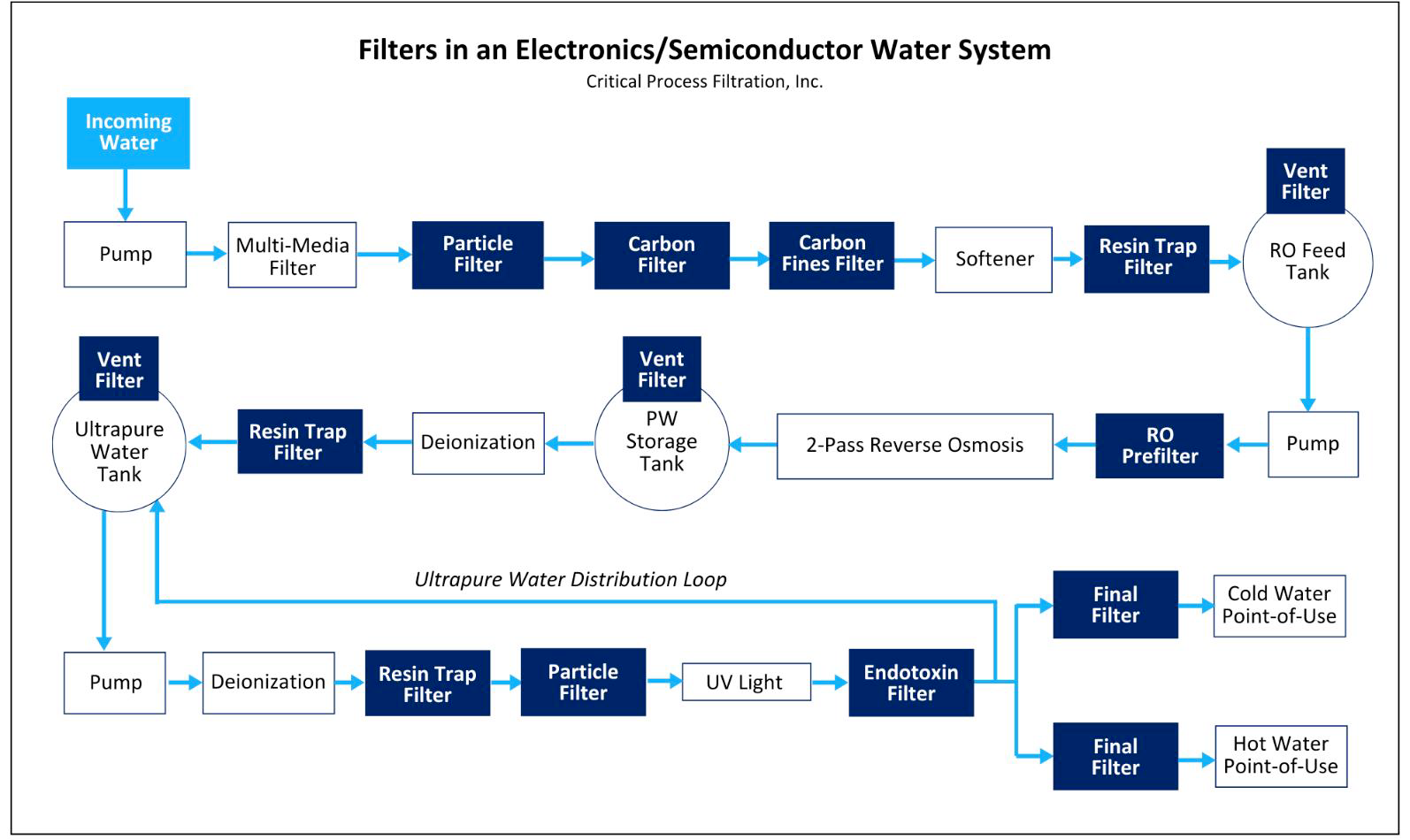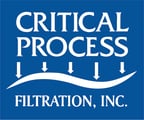The need for ultrapure water in electronics and semiconductor fabrication cannot be understated. Critical Process Filtration understands the cost of contaminated components and products is measured in both consumer safety and revenue.
As a manufacturer of filters designed to be used in critical processes, you can be assured that our proven products tested with your water will result in a reliable solution for your operation. The diagram below is a simplified version of a system producing ultrapure water. The dark blue boxes identify where CPF filters can support your operation. Working with our Application Engineers, your team will end up with the best filter configurations at all locations along the filtration train.

Normal filtration opportunities to assure ultrapure water. Dark blue boxes represent filters by Critical Process Filtration.
Filtration Steps in Ultrapure Water Treatment
Particles left by the multi-media filter
In-plant water systems typically begin with a multimedia filter to remove large contaminants such as rocks and sand that may be found in pre-plant filtrate. And there are always those untypical scenarios. For instance, one of our customers found a shoe that made it into their multimedia filter tank! Regardless of size, these large contaminants can release smaller particles that should be removed with a particle filter before they reach downstream components and clog them or otherwise interfere with the operation.
Organic Contaminants and Carbon Fines Trap
The carbon filter shown in the diagram is typically a granular, activated carbon filter that removes chlorine, chloramine, and other dissolved organic materials from the water supply. This protects downstream treatment components, particularly RO membranes, from oxidation. Unfortunately, all carbon filters produce carbon fines, so a particle filter is needed to remove them.
Resin Trap
There are two resin-based treatment processes illustrated in the system diagram, water softening and deionization. In both cases, the resin beads installed to treat the water will break down over time and introduce resin fines into the water supply. Filters are used to trap the fines and prevent them from traveling further downstream.
Reverse Osmosis Prefiltration
The quality of the incoming water determines how much filtration is needed to protect the RO membranes. The most important particle filter is the RO prefilter which removes larger particles (1 to 5 microns), depending on the system. This filter protects the high-pressure RO pump and keeps particles from reaching the RO membranes. Reducing particle loads prevents membrane fouling and performance loss due to particles. Longer membrane life means reduced system cleaning and maintenance expenses as well as lower replacement costs over the life of the system.
Filters in the Distribution Loop
The water in the distribution loop portion of the system is extremely pure and has few particles. The resin trap filter shown in the distribution loop is only an ‘insurance policy against potential system disruption. One potential disruption is bacterial contamination. There may also be particles generated by the simple wear and tear on components like pumps and valves from long-term system operation. Loop filters are usually rated at 0.03 microns or smaller and prevent bacteria or small particles from being sent to sensitive production processes.
Tank Vents
Filling a tank without venting can cause pressure inside the tank to increase, reducing process flow and in extreme cases causing a tank to rupture. Emptying a tank without a vent will result in vacuum buildup inside the tank, producing the same negative effect.
These vents must have proper filtration in-line to prevent potential contaminants - particles, bacteria, etc., in the surrounding environment from entering the tank during transfer.
Endotoxin Removal and Final Filters after the UV System
The UV is often followed by a filter which will remove any negatively charged bacteria debris generated in the UV chamber. These positively charged filters will ensure endotoxin removal. For added insurance, Critical Process Filtration offers endotoxin removal filters that also retain any bacteria that can potentially exist at this point.
Point-of-Use Final Filters
When Point-of-Use filters for either cold water or hot water are installed just before or inside the actual process tools they are usually rated 0.03 microns or smaller and capture bacteria or particles just before the water comes in contact with the semiconductor, media, or panel components being fabricated.
